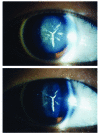Functions of the intermediate filament cytoskeleton in the eye lens
- PMID: 19587458
- PMCID: PMC2701874
- DOI: 10.1172/JCI38277
Functions of the intermediate filament cytoskeleton in the eye lens
Abstract
Intermediate filaments (IFs) are a key component of the cytoskeleton in virtually all vertebrate cells, including those of the lens of the eye. IFs help integrate individual cells into their respective tissues. This Review focuses on the lens-specific IF proteins beaded filament structural proteins 1 and 2 (BFSP1 and BFSP2) and their role in lens physiology and disease. Evidence generated in studies in both mice and humans suggests a critical role for these proteins and their filamentous polymers in establishing the optical properties of the eye lens and in maintaining its transparency. For instance, mutations in both BFSP1 and BFSP2 cause cataract in humans. We also explore the potential role of BFSP1 and BFSP2 in aging processes in the lens.
Figures







Similar articles
-
Seeing is believing! The optical properties of the eye lens are dependent upon a functional intermediate filament cytoskeleton.Exp Cell Res. 2005 Apr 15;305(1):1-9. doi: 10.1016/j.yexcr.2004.11.021. Epub 2005 Jan 26. Exp Cell Res. 2005. PMID: 15777782 Review.
-
Insights into the beaded filament of the eye lens.Exp Cell Res. 2007 Jun 10;313(10):2180-8. doi: 10.1016/j.yexcr.2007.04.005. Epub 2007 Apr 6. Exp Cell Res. 2007. PMID: 17490642 Free PMC article. Review.
-
The beaded intermediate filaments and their potential functions in eye lens.Bioessays. 1994 Jun;16(6):413-8. doi: 10.1002/bies.950160609. Bioessays. 1994. PMID: 8080431 Review.
-
Removal of Hsf4 leads to cataract development in mice through down-regulation of gamma S-crystallin and Bfsp expression.BMC Mol Biol. 2009 Feb 19;10:10. doi: 10.1186/1471-2199-10-10. BMC Mol Biol. 2009. PMID: 19224648 Free PMC article.
-
Bfsp2 mutation found in mouse 129 strains causes the loss of CP49 and induces vimentin-dependent changes in the lens fibre cell cytoskeleton.Exp Eye Res. 2004 Jan;78(1):109-23. doi: 10.1016/j.exer.2003.09.001. Exp Eye Res. 2004. Corrected and republished in: Exp Eye Res. 2004 Apr;78(4):875-89. doi: 10.1016/j.exer.2003.09.028. PMID: 14667833 Corrected and republished.
Cited by
-
Transgenic Overexpression of Myocilin Leads to Variable Ocular Anterior Segment and Retinal Alterations Associated with Extracellular Matrix Abnormalities in Adult Zebrafish.Int J Mol Sci. 2022 Sep 1;23(17):9989. doi: 10.3390/ijms23179989. Int J Mol Sci. 2022. PMID: 36077382 Free PMC article.
-
Congenital cataract - clinical and morphological aspects.Rom J Morphol Embryol. 2020;61(1):105-112. doi: 10.47162/RJME.61.1.11. Rom J Morphol Embryol. 2020. PMID: 32747900 Free PMC article.
-
Localization of αA-Crystallin in Rat Retinal Müller Glial Cells and Photoreceptors.Microsc Microanal. 2018 Oct;24(5):545-552. doi: 10.1017/S1431927618015118. Epub 2018 Sep 26. Microsc Microanal. 2018. PMID: 30253817 Free PMC article.
-
Tetraploidy in cancer and its possible link to aging.Cancer Sci. 2018 Sep;109(9):2632-2640. doi: 10.1111/cas.13717. Epub 2018 Jul 26. Cancer Sci. 2018. PMID: 29949679 Free PMC article. Review.
-
The oxidized thiol proteome in aging and cataractous mouse and human lens revealed by ICAT labeling.Aging Cell. 2017 Apr;16(2):244-261. doi: 10.1111/acel.12548. Epub 2016 Nov 13. Aging Cell. 2017. PMID: 28177569 Free PMC article.
References
Publication types
MeSH terms
Substances
Grants and funding
LinkOut - more resources
Full Text Sources
Other Literature Sources
Miscellaneous

